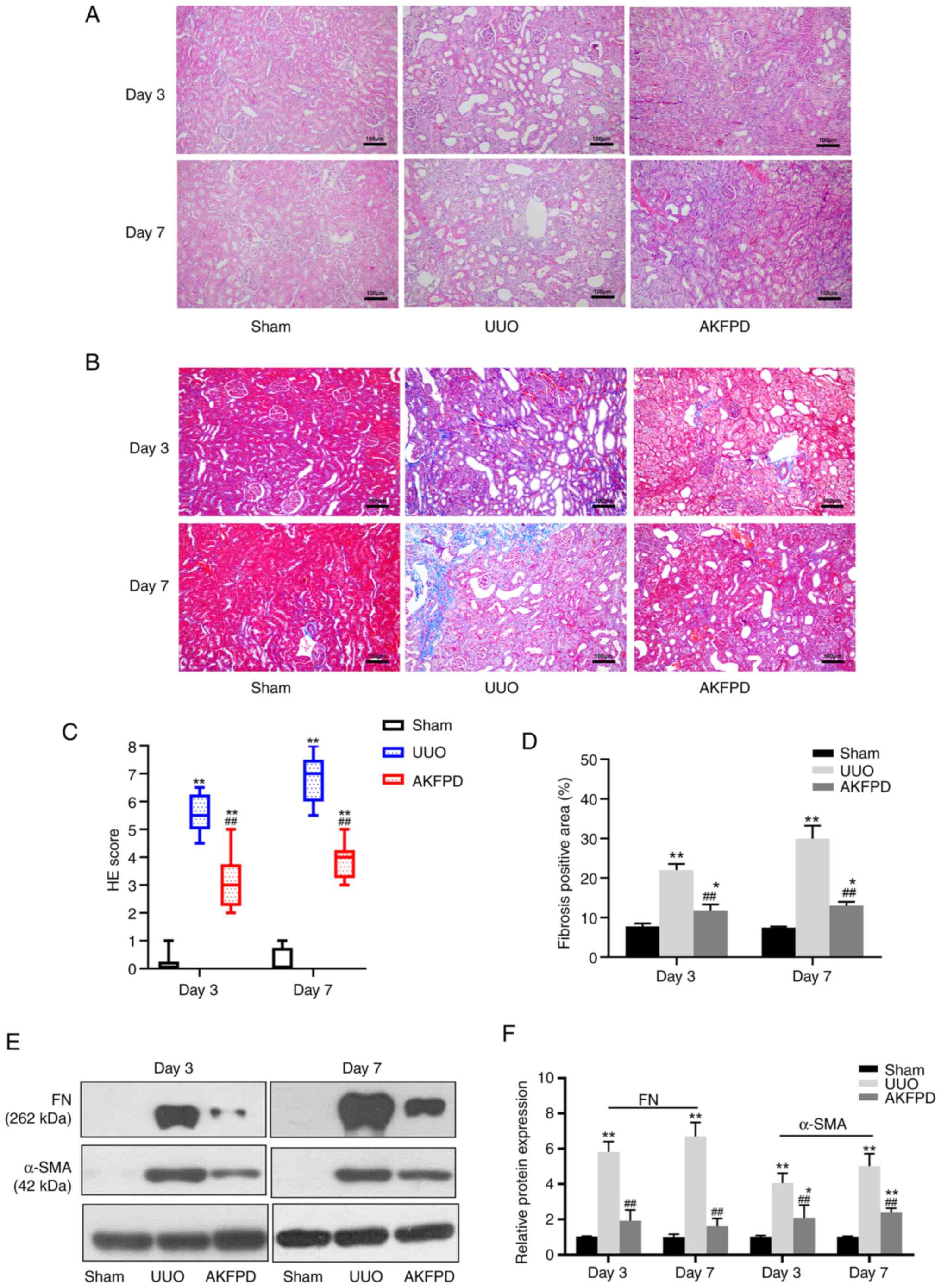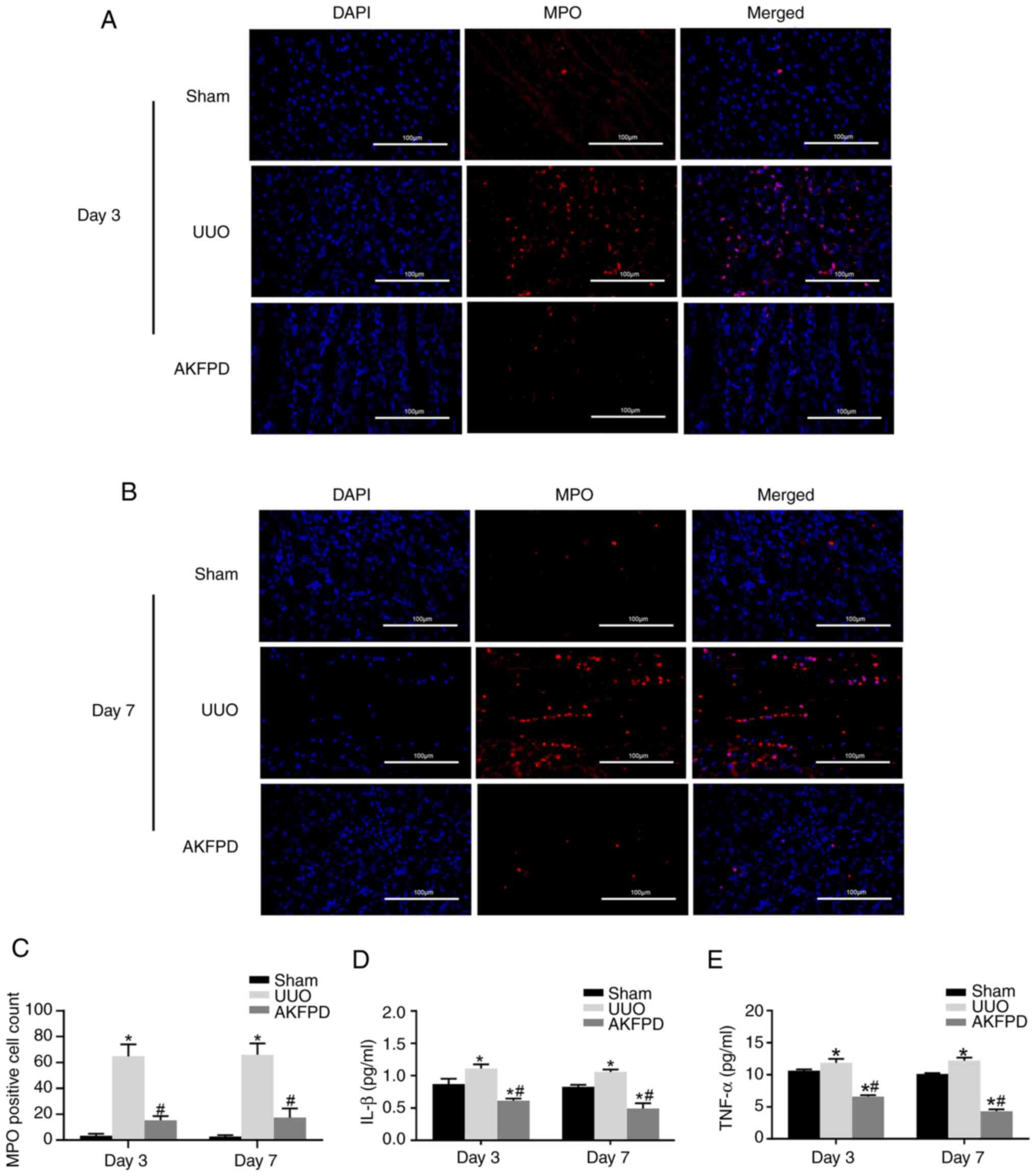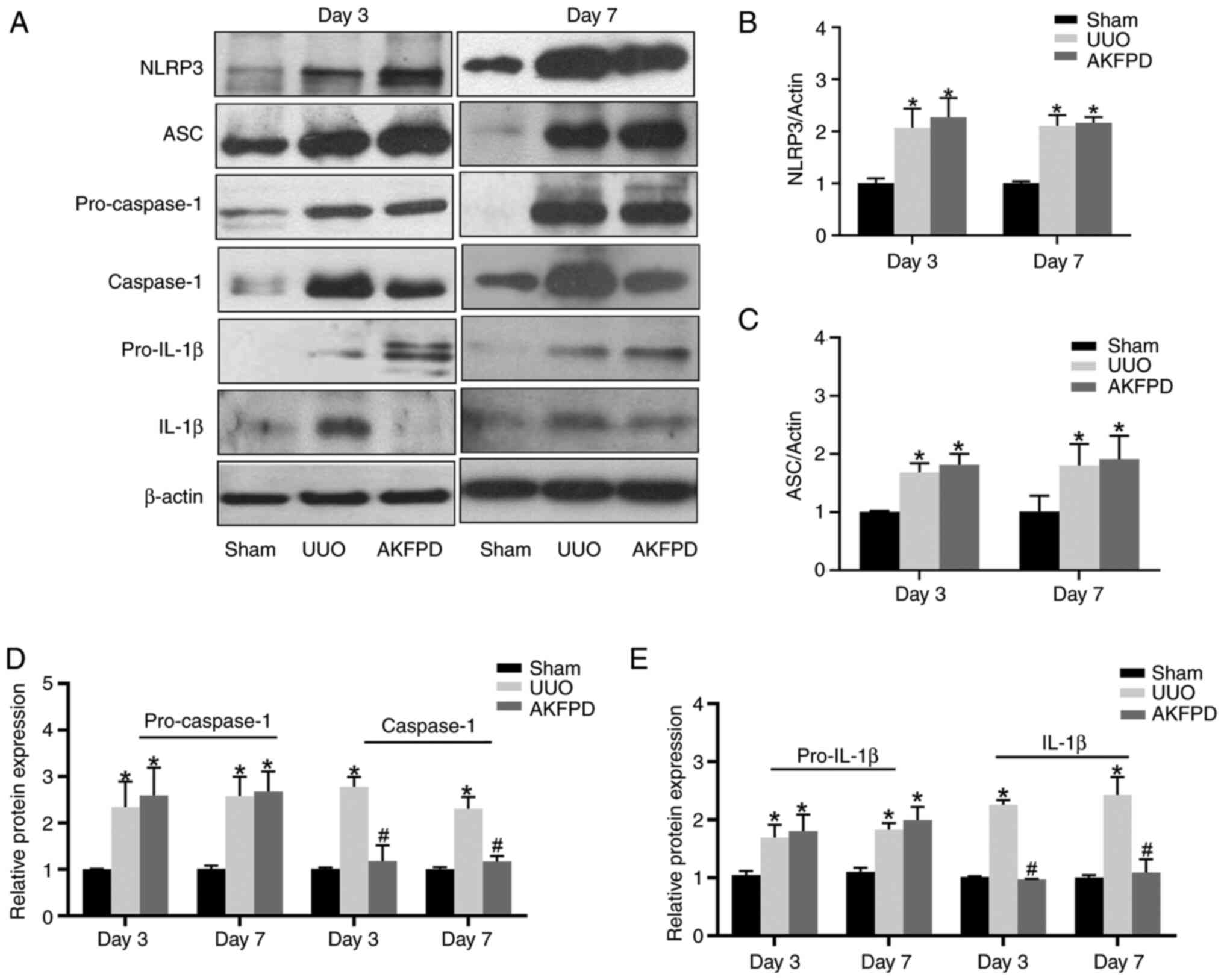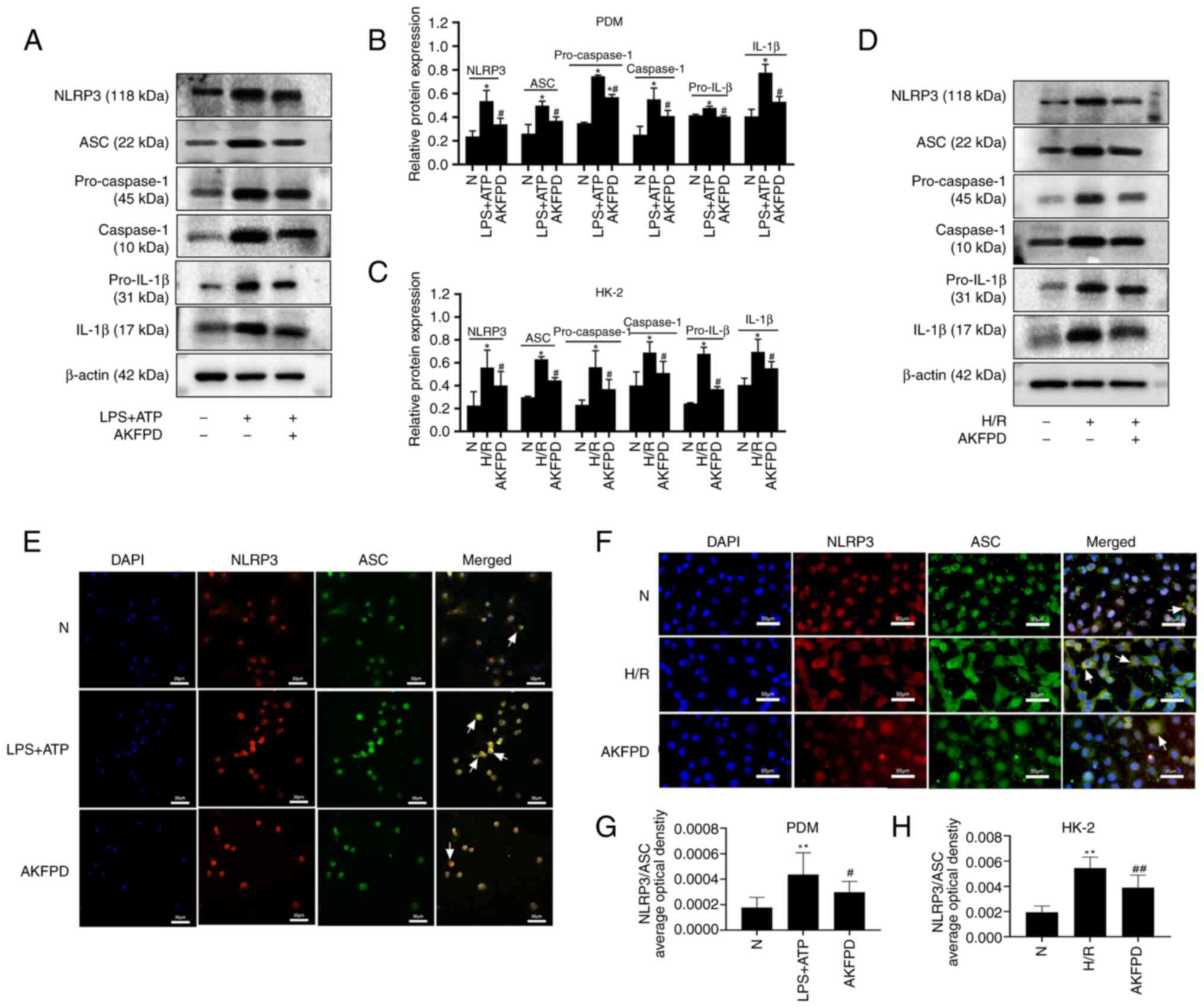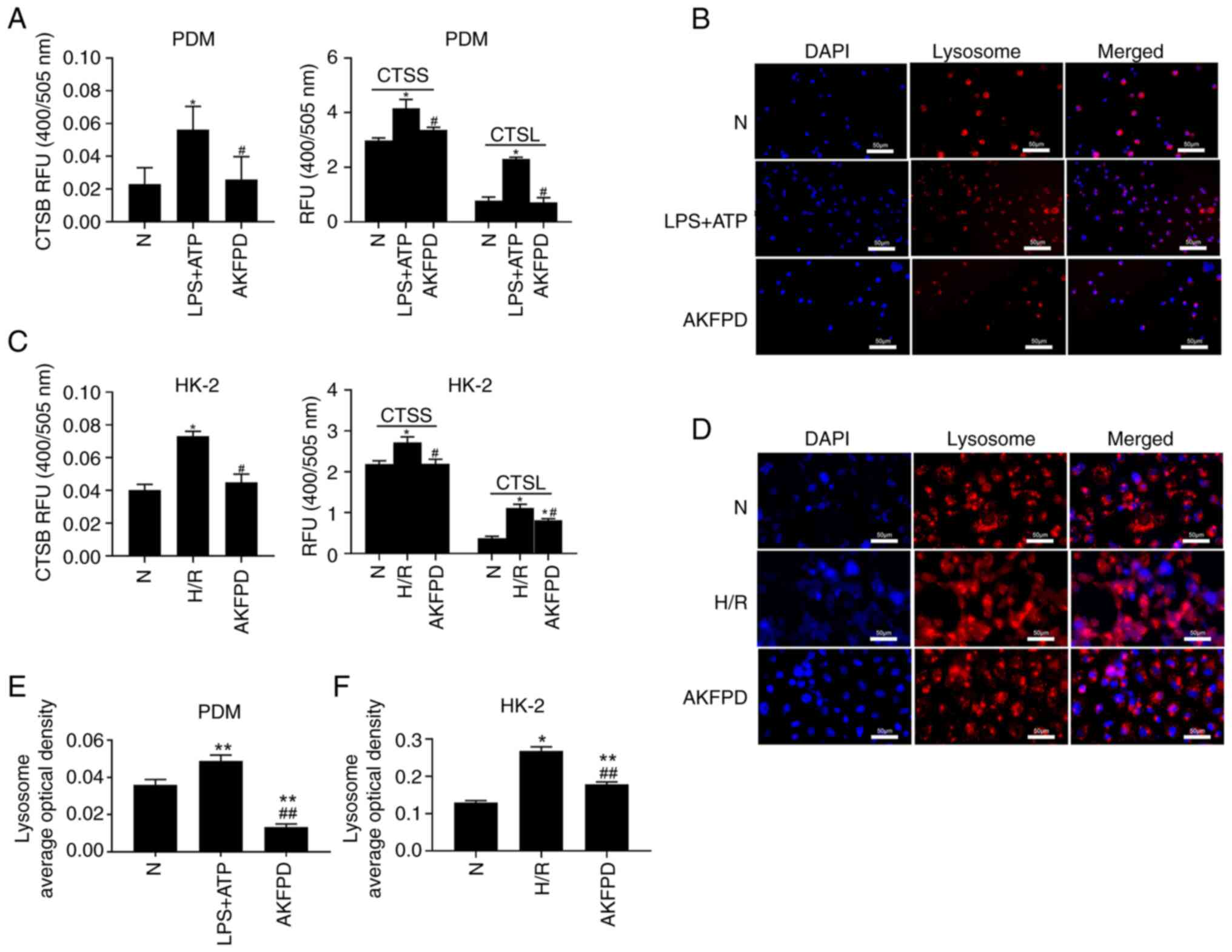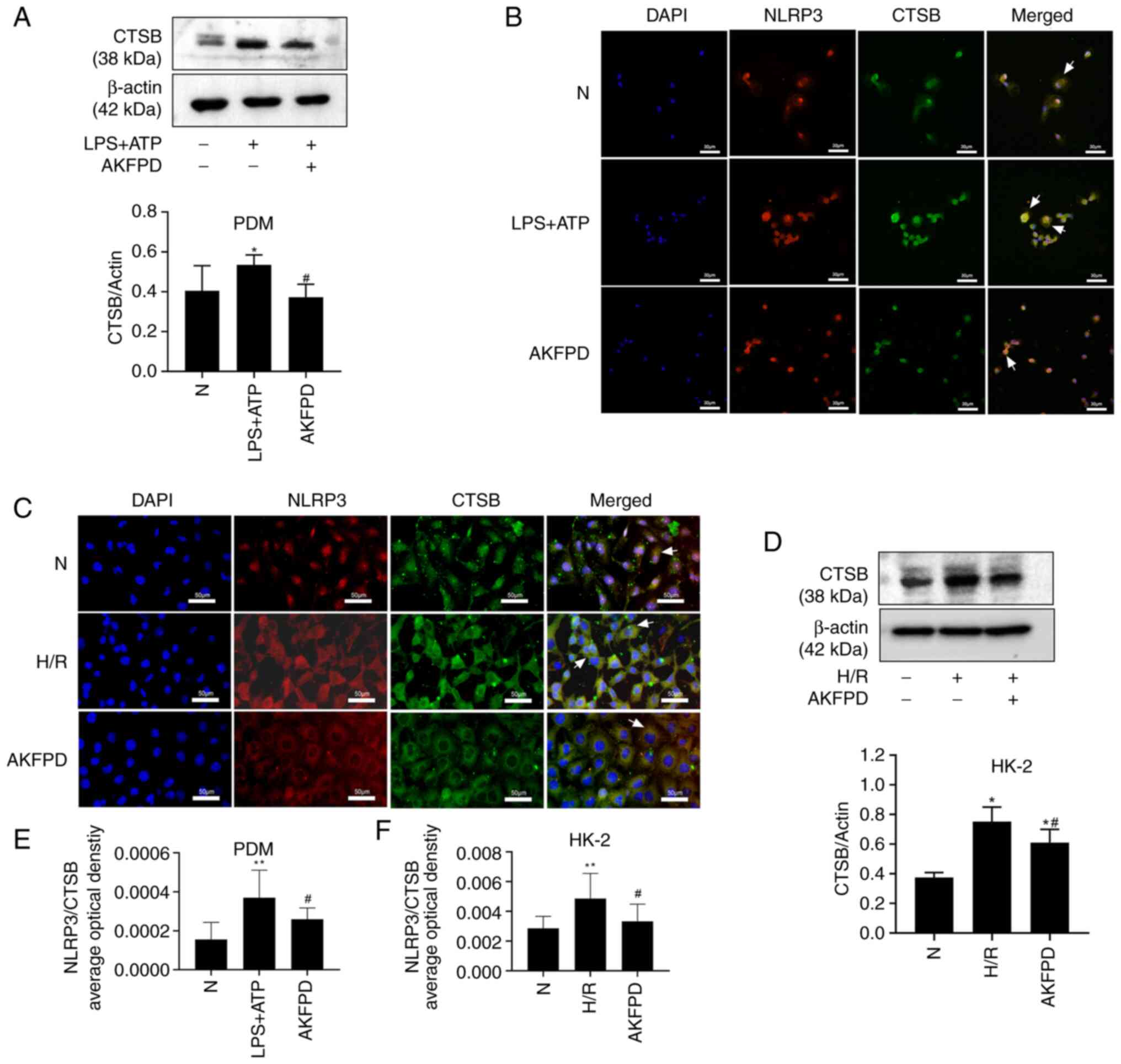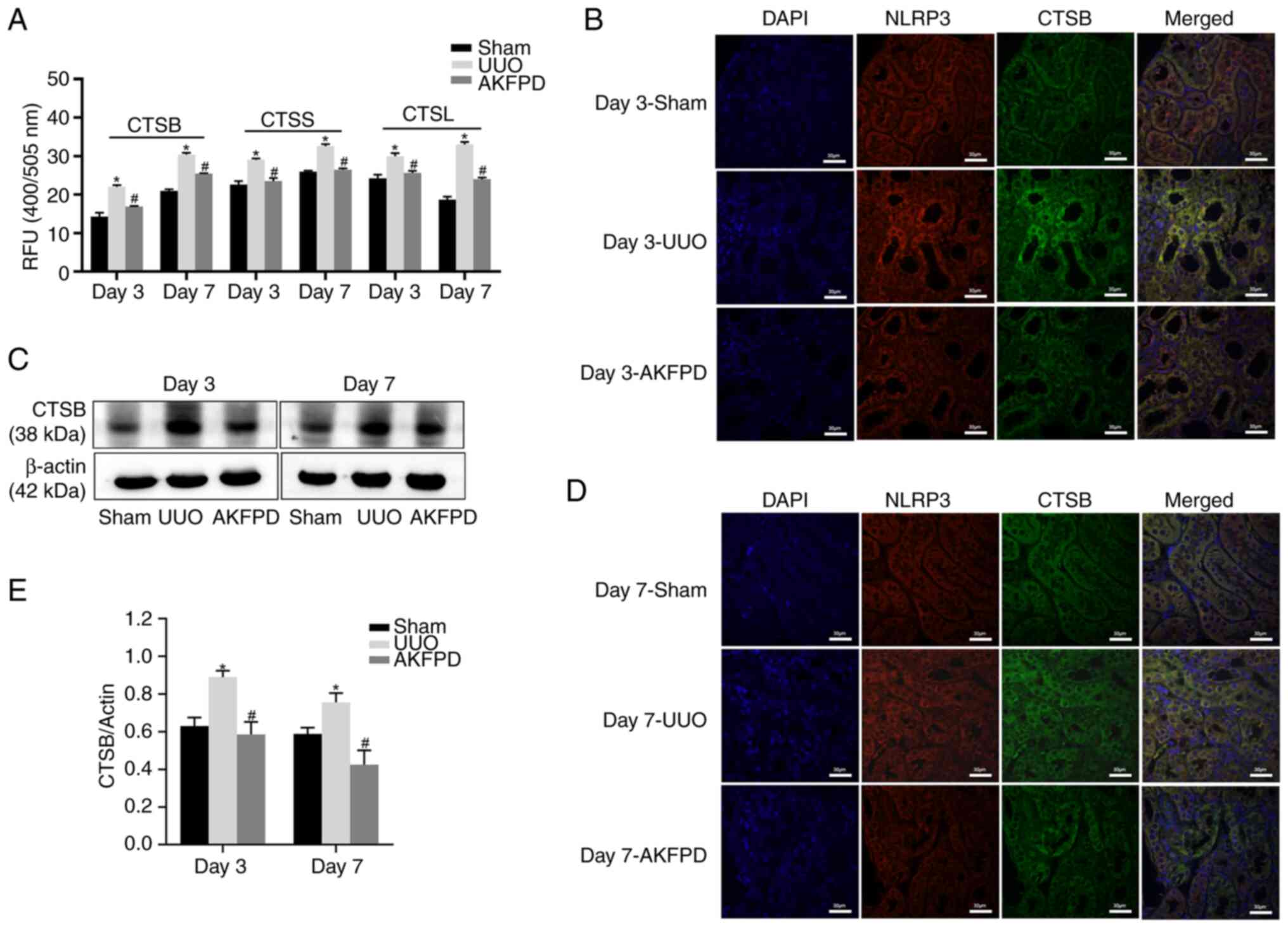|
1
|
Hackl MJ, Burford JL, Villanueva K, Lam L,
Suszták K, Schermer B, Benzing T and Peti-Peterdi J: Tracking the
fate of glomerular epithelial cells in vivo using serial
multiphoton imaging in new mouse models with fluorescent lineage
tags. Nat Med. 19:1661–1666. 2013.PubMed/NCBI View
Article : Google Scholar
|
|
2
|
Lovisa S, LeBleu VS, Tampe B, Sugimoto H,
Vadnagara K, Carstens JL, Wu CC, Hagos Y, Burckhardt BC,
Pentcheva-Hoang T, et al: Epithelial-to-mesenchymal transition
induces cell cycle arrest and parenchymal damage in renal fibrosis.
Nat Med. 21:998–1009. 2015.PubMed/NCBI View
Article : Google Scholar
|
|
3
|
Li X, Pan J, Li H, Li G, Liu X, Liu B, He
Z, Peng Z, Zhang H, Li Y, et al: DsbA-L mediated renal
tubulointerstitial fibrosis in UUO mice. Nat Commun.
11(4467)2020.PubMed/NCBI View Article : Google Scholar
|
|
4
|
Meng XM, Nikolic-Paterson DJ and Lan HY:
Inflammatory processes in renal fibrosis. Nat Rev Nephrol.
10:493–503. 2014.PubMed/NCBI View Article : Google Scholar
|
|
5
|
Kimura T, Isaka Y and Yoshimori T:
Autophagy and kidney inflammation. Autophagy. 13:997–1003.
2017.PubMed/NCBI View Article : Google Scholar
|
|
6
|
Jo EK, Kim JK, Shin DM and Sasakawa C:
Molecular mechanisms regulating NLRP3 inflammasome activation. Cell
Mol Immunol. 13:148–159. 2016.PubMed/NCBI View Article : Google Scholar
|
|
7
|
Alyaseer AAA, de Lima MHS and Braga TT:
The role of NLRP3 inflammasome activation in the epithelial to
mesenchymal transition process during the fibrosis. Front Immunol.
11(883)2020.PubMed/NCBI View Article : Google Scholar
|
|
8
|
Song H, Zhao C, Yu Z, Li Q, Yan R, Qin Y,
Jia M and Zhao W: UAF1 deubiquitinase complexes facilitate NLRP3
inflammasome activation by promoting NLRP3 expression. Nat Commun.
11(6042)2020.PubMed/NCBI View Article : Google Scholar
|
|
9
|
Bakker PJ, Butter LM, Claessen N, Teske
GJ, Sutterwala FS, Florquin S and Leemans JC: A tissue-specific
role for Nlrp3 in tubular epithelial repair after renal
ischemia/reperfusion. Am J Pathol. 184:2013–2022. 2014.PubMed/NCBI View Article : Google Scholar
|
|
10
|
Vilaysane A, Chun J, Seamone ME, Wang W,
Chin R, Hirota S, Li Y, Clark SA, Tschopp J, Trpkov K, et al: The
NLRP3 inflammasome promotes renal inflammation and contributes to
CKD. J Am Soc Nephrol. 21:1732–1744. 2010.PubMed/NCBI View Article : Google Scholar
|
|
11
|
He H, Jiang H, Chen Y, Ye J, Wang A, Wang
C, Liu Q, Liang G, Deng X, Jiang W and Zhou R: Oridonin is a
covalent NLRP3 inhibitor with strong anti-inflammasome activity.
Nat Commun. 9(2550)2018.PubMed/NCBI View Article : Google Scholar
|
|
12
|
Kim SM, Kim YG, Kim DJ, Park SH, Jeong KH,
Lee YH, Lim SJ, Lee SH and Moon JY: Inflammasome-independent role
of NLRP3 mediates mitochondrial regulation in renal injury. Front
Immunol. 9(2563)2018.PubMed/NCBI View Article : Google Scholar
|
|
13
|
Cocchiaro P, De Pasquale V, Della Morte R,
Tafuri S, Avallone L, Pizard A, Moles A and Pavone LM: The
multifaceted role of the lysosomal protease cathepsins in kidney
disease. Front Cell Dev Biol. 5(114)2017.PubMed/NCBI View Article : Google Scholar
|
|
14
|
Fox C, Cocchiaro P, Oakley F, Howarth R,
Callaghan K, Leslie J, Luli S, Wood KM, Genovese F, Sheerin NS and
Moles A: Inhibition of lysosomal protease cathepsin D reduces renal
fibrosis in murine chronic kidney disease. Sci Rep.
6(20101)2016.PubMed/NCBI View Article : Google Scholar
|
|
15
|
Musante L, Tataruch D, Gu D, Liu X,
Forsblom C, Groop PH and Holthofer H: Proteases and protease
inhibitors of urinary extracellular vesicles in diabetic
nephropathy. J Diabetes Res. 2015(289734)2015.PubMed/NCBI View Article : Google Scholar
|
|
16
|
Tang TT, Lv LL, Pan MM, Wen Y, Wang B, Li
ZL, Wu M, Wang FM, Crowley SD and Liu BC: Hydroxychloroquine
attenuates renal ischemia/reperfusion injury by inhibiting
cathepsin mediated NLRP3 inflammasome activation. Cell Death Dis.
9(351)2018.PubMed/NCBI View Article : Google Scholar
|
|
17
|
Allan ERO, Campden RI, Ewanchuk BW, Tailor
P, Balce DR, McKenna NT, Greene CJ, Warren AL, Reinheckel T and
Yates RM: A role for cathepsin Z in neuroinflammation provides
mechanistic support for an epigenetic risk factor in multiple
sclerosis. J Neuroinflammation. 14(103)2017.PubMed/NCBI View Article : Google Scholar
|
|
18
|
Meng J, Zou Y, Hu C, Zhu Y, Peng Z, Hu G,
Wang Z and Tao L: Fluorofenidone attenuates bleomycin-induced
pulmonary inflammation and fibrosis in mice via restoring caveolin
1 expression and inhibiting mitogen-activated protein kinase
signaling pathway. Shock. 38:567–573. 2012.PubMed/NCBI View Article : Google Scholar
|
|
19
|
Peng ZZ, Hu GY, Shen H, Wang L, Ning WB,
Xie YY, Wang NS, Li BX, Tang YT and Tao LJ: Fluorofenidone
attenuates collagen I and transforming growth factor-beta1
expression through a nicotinamide adenine dinucleotide phosphate
oxidase-dependent way in NRK-52E cells. Nephrology (Carlton).
14:565–572. 2009.PubMed/NCBI View Article : Google Scholar
|
|
20
|
Peng Y, Yang H, Zhu T, Zhao M, Deng Y, Liu
B, Shen H, Hu G, Wang Z and Tao L: The antihepatic fibrotic effects
of fluorofenidone via MAPK signalling pathways. Eur J Clin Invest.
43:358–368. 2013.PubMed/NCBI View Article : Google Scholar
|
|
21
|
Ning WB, Hu GY, Peng ZZ, Wang L, Wang W,
Chen JY, Zheng X, Li J and Tao LJ: Fluorofenidone inhibits Ang
II-induced apoptosis of renal tubular cells through blockage of the
Fas/FasL pathway. Int Immunopharmacol. 11:1327–1332.
2011.PubMed/NCBI View Article : Google Scholar
|
|
22
|
Tu S, Jiang Y, Cheng H, Yuan X, He Y, Peng
Y, Peng X, Peng Z, Tao L and Yang H: Fluorofenidone protects liver
against inflammation and fibrosis by blocking the activation of
NF-κB pathway. FASEB J. 35(e21497)2021.PubMed/NCBI View Article : Google Scholar
|
|
23
|
Tang Y, Zhang F, Huang L, Yuan Q, Qin J,
Li B, Wang N, Xie Y, Wang L, Wang W, et al: The protective
mechanism of fluorofenidone in renal interstitial inflammation and
fibrosis. Am J Med Sci. 350:195–203. 2015.PubMed/NCBI View Article : Google Scholar
|
|
24
|
Kocak MZ, Aktas G, Atak BM, Duman TT, Yis
OM, Erkus E and Savli H: Is Neuregulin-4 a predictive marker of
microvascular complications in type 2 diabetes mellitus? Eur J Clin
Invest. 50(e13206)2020.PubMed/NCBI View Article : Google Scholar
|
|
25
|
Bilgin S, Kurtkulagi O, Atak BM, Duman TT,
Kahveci G, Khalid A and Aktas G: Does C-reactive protein to serum
albumin ratio correlate with diabetic nephropathy in patients with
type 2 diabetes mellitus? The care time study. Prim Care Diabetes.
15:1071–1074. 2021.PubMed/NCBI View Article : Google Scholar
|
|
26
|
Aktas G, Yilmaz S, Kantarci DB, Duman TT,
Bilgin S, Balci SB and Atak BM: Is serum uric acid-to-HDL
cholesterol ratio elevation associated with diabetic kidney injury?
Postgrad Med. 135:519–523. 2023.PubMed/NCBI View Article : Google Scholar
|
|
27
|
Taslamacioglu Duman T, Ozkul FN and Balci
B: Could systemic inflammatory index predict diabetic kidney injury
in type 2 diabetes mellitus? Diagnostics (Basel).
13(2063)2023.PubMed/NCBI View Article : Google Scholar
|
|
28
|
Zheng L, Zhang J, Yuan X, Tang J, Qiu S,
Peng Z, Yuan Q, Xie Y, Mei W, Tang Y, et al: Fluorofenidone
attenuates interleukin-1β production by interacting with NLRP3
inflammasome in unilateral ureteral obstruction. Nephrology
(Carlton). 23:573–584. 2018.PubMed/NCBI View Article : Google Scholar
|
|
29
|
Liao X, Jiang Y, Dai Q, Yu Y, Zhang Y, Hu
G, Meng J, Xie Y, Peng Z and Tao L: Fluorofenidone attenuates renal
fibrosis by inhibiting the mtROS-NLRP3 pathway in a murine model of
folic acid nephropathy. Biochem Biophys Res Commun. 534:694–701.
2021.PubMed/NCBI View Article : Google Scholar
|
|
30
|
Chevalier RL, Forbes MS and Thornhill BA:
Ureteral obstruction as a model of renal interstitial fibrosis and
obstructive nephropathy. Kidney Int. 75:1145–1152. 2009.PubMed/NCBI View Article : Google Scholar
|
|
31
|
Lu M, Li H, Liu W, Zhang X, Li L and Zhou
H: Curcumin attenuates renal interstitial fibrosis by regulating
autophagy and retaining mitochondrial function in unilateral
ureteral obstruction rats. Basic Clin Pharmacol Toxicol.
128:594–604. 2021.PubMed/NCBI View Article : Google Scholar
|
|
32
|
Lu M, Yang W, Peng Z, Zhang J, Mei W, Liu
C, Tang J, Ma H, Yuan X, Meng J, et al: Fluorofenidone inhibits
macrophage IL-1β production by suppressing inflammasome activity.
Int Immunopharmacol. 27:148–153. 2015.PubMed/NCBI View Article : Google Scholar
|
|
33
|
Zhang J, Zheng L, Yuan X, Liu C, Yuan Q,
Xie F, Qiu S, Peng Z, Tang Y, Meng J, et al: Mefunidone ameliorates
renal inflammation and tubulointerstitial fibrosis via suppression
of IKKβ phosphorylation. Int J Biochem Cell Biol. 80:109–118.
2016.PubMed/NCBI View Article : Google Scholar
|
|
34
|
Xiang H, Zhu F, Xu Z and Xiong J: Role of
inflammasomes in kidney diseases via both canonical and
non-canonical pathways. Front Cell Dev Biol. 8(106)2020.PubMed/NCBI View Article : Google Scholar
|
|
35
|
Imig JD and Ryan MJ: Immune and
inflammatory role in renal disease. Compr Physiol. 3:957–976.
2013.PubMed/NCBI View Article : Google Scholar
|
|
36
|
Jiang Y, Quan J, Chen Y, Liao X, Dai Q, Lu
R, Yu Y, Hu G, Li Q, Meng J, et al: Fluorofenidone protects against
acute kidney injury. FASEB J. 33:14325–14336. 2019.PubMed/NCBI View Article : Google Scholar
|
|
37
|
Seo JB, Choi YK, Woo HI, Jung YA, Lee S,
Lee S, Park M, Lee IK, Jung GS and Park KG: Gemigliptin attenuates
renal fibrosis through down-regulation of the NLRP3 inflammasome.
Diabetes Metab J. 43:830–839. 2019.PubMed/NCBI View Article : Google Scholar
|
|
38
|
Zheng Z, Xu K, Li C, Qi C, Fang Y, Zhu N,
Bao J, Zhao Z, Yu Q, Wu H and Liu J: NLRP3 associated with chronic
kidney disease progression after ischemia/reperfusion-induced acute
kidney injury. Cell Death Discov. 7(324)2021.PubMed/NCBI View Article : Google Scholar
|
|
39
|
Bhatia D, Chung KP, Nakahira K, Patino E,
Rice MC, Torres LK, Muthukumar T, Choi AM, Akchurin OM and Choi ME:
Mitophagy-dependent macrophage reprogramming protects against
kidney fibrosis. JCI Insight. 4(e132826)2019.PubMed/NCBI View Article : Google Scholar
|
|
40
|
Lorenz G, Darisipudi MN and Anders HJ:
Canonical and non-canonical effects of the NLRP3 inflammasome in
kidney inflammation and fibrosis. Nephrol Dial Transplant.
29:41–48. 2014.PubMed/NCBI View Article : Google Scholar
|
|
41
|
Conley SM, Abais JM, Boini KM and Li PL:
Inflammasome activation in chronic glomerular diseases. Curr Drug
Targets. 18:1019–1029. 2017.PubMed/NCBI View Article : Google Scholar
|
|
42
|
Orlowski GM, Colbert JD, Sharma S, Bogyo
M, Robertson SA and Rock KL: Multiple cathepsins promote Pro-IL-1β
synthesis and NLRP3-Mediated IL-1β activation. J Immunol.
195:1685–1697. 2015.PubMed/NCBI View Article : Google Scholar
|
|
43
|
Kelley N, Jeltema D, Duan Y and He Y: The
NLRP3 inflammasome: An overview of mechanisms of activation and
regulation. Int J Mol Sci. 20(3328)2019.PubMed/NCBI View Article : Google Scholar
|
|
44
|
Martine P and Rébé C: Heat shock proteins
and inflammasomes. Int J Mol Sci. 20(4508)2019.PubMed/NCBI View Article : Google Scholar
|
|
45
|
Bozic M, Caus M, Rodrigues-Diez RR,
Pedraza N, Ruiz-Ortega M, Garí E, Gallel P, Panadés MJ, Martinez A,
Fernández E and Valdivielso JM: Protective role of renal proximal
tubular alpha-synuclein in the pathogenesis of kidney fibrosis. Nat
Commun. 11(1943)2020.PubMed/NCBI View Article : Google Scholar
|
|
46
|
Dai Q, Zhang Y, Liao X, Jiang Y, Lv X,
Yuan X, Meng J, Xie Y, Peng Z, Yuan Q, et al: Fluorofenidone
alleviates renal fibrosis by inhibiting necroptosis through
RIPK3/MLKL pathway. Front Pharmacol. 11(534775)2020.PubMed/NCBI View Article : Google Scholar
|
|
47
|
Yang H, Zhang W, Xie T, Wang X and Ning W:
Fluorofenidone inhibits apoptosis of renal tubular epithelial cells
in rats with renal interstitial fibrosis. Braz J Med Biol Res.
52(e8772)2019.PubMed/NCBI View Article : Google Scholar
|
|
48
|
Wu M, Han W, Song S, Du Y, Liu C, Chen N,
Wu H, Shi Y and Duan H: NLRP3 deficiency ameliorates renal
inflammation and fibrosis in diabetic mice. Mol Cell Endocrinol.
478:115–125. 2018.PubMed/NCBI View Article : Google Scholar
|
|
49
|
Mulay SR: Multifactorial functions of the
inflammasome component NLRP3 in pathogenesis of chronic kidney
diseases. Kidney Int. 96:58–66. 2019.PubMed/NCBI View Article : Google Scholar
|
|
50
|
Li L, Tang W and Yi F: Role of
inflammasome in chronic kidney disease. Adv Exp Med Biol.
1165:407–421. 2019.PubMed/NCBI View Article : Google Scholar
|
|
51
|
Lamkanfi M: Emerging inflammasome effector
mechanisms. Nat Rev Immunol. 11:213–220. 2011.PubMed/NCBI View Article : Google Scholar
|
|
52
|
Man SM and Kanneganti TD: Regulation of
inflammasome activation. Immunol Rev. 265:6–21. 2015.PubMed/NCBI View Article : Google Scholar
|
|
53
|
Terada K, Yamada J, Hayashi Y, Wu Z,
Uchiyama Y, Peters C and Nakanishi H: Involvement of cathepsin B in
the processing and secretion of interleukin-1beta in chromogranin
A-stimulated microglia. Glia. 58:114–124. 2010.PubMed/NCBI View Article : Google Scholar
|
|
54
|
Stancu IC, Cremers N, Vanrusselt H,
Couturier J, Vanoosthuyse A, Kessels S, Lodder C, Brône B, Huaux F,
Octave JN, et al: Aggregated Tau activates NLRP3-ASC inflammasome
exacerbating exogenously seeded and non-exogenously seeded Tau
pathology in vivo. Acta Neuropathol. 137:599–617. 2019.PubMed/NCBI View Article : Google Scholar
|
|
55
|
Chevriaux A, Pilot T, Derangere V, Simonin
H, Martine P, Chalmin F, Ghiringhelli F and Rébé C: Cathepsin B is
required for NLRP3 inflammasome activation in macrophages, through
NLRP3 interaction. Front Cell Dev Biol. 8(167)2020.PubMed/NCBI View Article : Google Scholar
|
|
56
|
Nakahira K, Haspel JA, Rathinam VA, Lee
SJ, Dolinay T, Lam HC, Englert JA, Rabinovitch M, Cernadas M, Kim
HP, et al: Autophagy proteins regulate innate immune responses by
inhibiting the release of mitochondrial DNA mediated by the NALP3
inflammasome. Nat Immunol. 12:222–230. 2011.PubMed/NCBI View Article : Google Scholar
|















